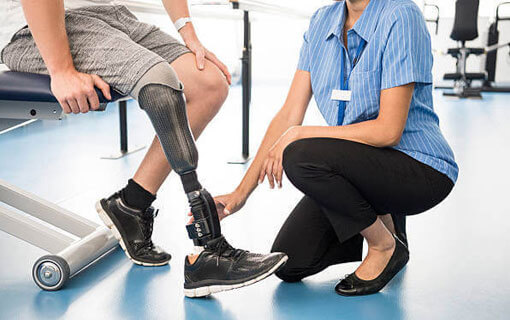SUMMARY Prostheses are intended to restore the normal functions of the missing body part.[4] Amputee rehabilitation is primarily coordinated by a physiatrist as part of an inter-disciplinary team consisting of physiatrists, prosthetists, nurses, physical therapists, and occupational therapists. Wikipedia
When you’ve lost a limb due to an accident or have had an amputation, a prosthetic device may be necessary to help you regain mobility and independence.
Several factors come into play in determining the success of your healing process, but it starts with a properly prosthetic fitting and the maintenance of quality prosthetic care.
In this article, we’ll discuss the orthotic and prosthetic fitting processes, what the different prosthetic fitting devices are, the supplies needed for prosthetic fitting, and more.
What’s the Difference Between the Orthotic and Prosthetic Processes?
 Before we get into detail, it’s important to delineate between the two terms.
Before we get into detail, it’s important to delineate between the two terms.
Orthotic care refers to the design, manufacture, and prosthetic fitting of devices that support or correct the function of the body. This includes everything from braces to artificial limbs.
Prosthesis care, on the other hand, is the process of designing and prosthetic fitting devices that replace a missing limb or body part. This includes prosthetic devices such as artificial limbs, breast prostheses, and more.
The prosthetic fitting process begins with an evaluation by a prosthetist, who will take measurements and casts to create a model of the residual limb. From there, they’ll design and fit a prosthesis that’s unique to the individual.
The process for orthotic services is more or less the same, although the devices themselves will differ.
What Are the Different Types of Prostheses?
There are different types of prosthetic fitting, and each type has its own set of supplies that you’ll need in order to get a comfortable fit. The most common types of prostheses depending on the stage of orthotic care are:
Postoperative Prostheses
Postoperative prostheses are used immediately following an amputation or surgery. The prosthesis is used to help the patient adapt to their new body and begin their rehabilitation.
Initial Prostheses
Initial prostheses are used after the surgical site has healed and the patient has completed their rehabilitation.
Preparatory Prostheses
Preparatory prostheses are used to help the patient get used to the idea of wearing a prosthesis and to train them on how to use it.
Definitive Prostheses
Definitive prostheses are the most advanced type of prosthesis and are meant to be a long-term solution.
Special-Use Prostheses
Special-use prostheses are designed for specific needs or activities, such as swimming or running.
In addition, there are two main types of prosthetic devices:
- Upper extremity prosthetics: These prostheses are used to replace an arm or a hand.
- Lower extremity prosthetics: These prostheses are used to replace a leg or a foot.
Other types of prosthetic devices worth mentioning are mobile prosthetics, which are prostheses that are designed to be used with a smartphone or tablet. These prostheses are becoming increasingly popular as they offer more freedom and independence to patients.
Prosthetic limbs are designed to help you function better in your daily life. In fact, with the right prosthesis, you can do everything that make your life yours. However, it’s also important that you get the best possible fit during your prosthetic fitting process.
Here’s a closer look at why getting the right prosthesis matters, what parts make up the prosthesis, and how a guide to getting a proper fit can help you along the way.
10 Most Important Supplies for Prosthetics
Prosthetic fitting involves a number of different supplies, but some are more important than others. Here are 10 of the most important prosthetic supplies that you’ll need for a comfortable fit:
- Prosthetic Socket
A prosthetic socket is the part of the prosthesis that fits over the residual limb and attaches to the prosthetic devices. It’s important to get a comfortable, well-fitting socket in order to avoid any issues with chafing or discomfort. - Silicone Liner for Prosthetic Leg
A silicone liner is a thin, soft sleeve that’s worn under the prosthetic socket. It helps to protect the residual limb and provides cushioning for added comfort. - Gel Liner
In addition to a silicone liner, you may also want to consider a gel liner. Gel liners are thicker and provide more cushioning than silicone liners. They’re often used for people with sensitive skin or for those who need extra padding. - Prosthetic Socks
Prosthetic socks are worn over the prosthetic liner in order to provide additional cushioning and support. They also help to absorb sweat and keep the prosthesis clean. - Shrinkers
Shrinkers are compression garments that are worn over the prosthetic liner. They help to reduce swelling and provide support for the limb. - Suspension Sleeve for Prosthetics
A suspension sleeve is worn over the prosthetic socket and helps to keep the prosthesis in place. It’s important to choose a sleeve that’s comfortable and won’t slip or slide. - Compression Sleeve
Like a shrinker, a compression sleeve is worn over the prosthetic liner. However, a compression sleeve is more for comfort than for support. - Antiperspirants
It’s important to use an antiperspirant or deodorant when wearing a prosthesis, as sweat can cause the prosthesis to slip or slide. - Skin Dressings
Skin dressings are used to help protect the skin and prevent irritation. They can be used under the prosthetic socket or over the entire limb. - Antibacterial Soap
Antibacterial soap is used to clean the prosthesis and the skin. It’s important to use a gentle, non-irritating soap to avoid any skin problems.
What Makes a Good and Comfortable Prosthetic Fitting?
A good prosthetic fitting is important for both comfort and function. Here are some of the signs that your prosthetic device is a good, comfortable fit:
Snug and comfortable
The prosthesis should be snug but not too tight, and it should stay in place without sliding or slipping. This is important to avoid any chafing or discomfort.
Range of motion
The prosthesis should also be the right size and shape for your body. The prosthesis should allow you to move freely and without pain. If you’re having difficulty moving, the prosthesis may be too tight or it may be rubbing against your skin.
No skin problems
Skin problems like rashes, blisters, or sores can indicate that the prosthesis is not a good fit. If you have any skin problems, be sure to let the prosthetist or health care providers know so they can make any necessary adjustments.
Gaps in Knowledge
Despite all the technological advances in prosthetics, evidence gaps exist related to the outcomes of using these devices. In particular, more research is needed to assess:
- The long-term effects of using myoelectric devices
- The long-term effects of using bionic devices
- The long-term effects of using implantable devices
In addition, there is a need for more research on the psychological effects of using prosthetic devices. This includes studies that assess issues such as body image, self-esteem, and quality of life.
For more information
The right fit for your prosthesis can greatly improve your quality of life. If you have questions about the prosthetic fitting process, contact Alltech Prosthetics today at (817) 484-9699, or fill out this form to schedule an appointment.
What are the considerations for choosing a prosthetic device?
The type of prosthetic device that is chosen will depend on a number of factors, including the level of amputation, patient characteristics such as age and activity level, and the preference of the patient.
What are the risks of using a prosthetic device?
There are a number of risks that are associated with using prosthetic devices, including infection, skin breakdown, and stump soreness. In addition, there is a risk of developing phantom limb pain. This is a type of pain that is felt in the limb that has been amputated.
How much does a lower limb prosthesis typically cost?
The cost of a lower limb prosthesis can vary depending on the type of device that is chosen. For example, a transtibial prosthesis can cost anywhere from $5,000 to $10,000. A transfemoral prosthesis can cost anywhere from $8,000 to $30,000.
The costs will also depend on the insurance coverage that is available and the Medicare functional classification level that is assigned to the patient. The beneficiary’s past medical history is also considered when determining the costs.
What is a Medicare functional classification level?
There are five different Medicare functional classification levels for lower limb prosthetics. They are as follows:
- K0 – The patient does not use a prosthetic device and does not have a residual limb.
- K1 – The patient uses a prosthetic device on a limited basis.
- K2 – The patient uses a prosthetic device on a regular basis.
- K3 – The patient uses a prosthetic device and has significant functional limitations.
- K4 – The patient uses a prosthetic device and has the ability to ambulate without assistive devices.
Can you wear a lower limb prosthesis all day?
It is typically recommended that patients only wear their Lower Limb Prosthetic for a few hours at a time. This is to allow the skin to breathe and prevent the development of sores.
How do you train an amputee?
There are a number of different ways that amputees can be trained to use their prosthetic devices. This includes physical therapy, occupational therapy, and prosthetist-led training sessions.
Support system training is also important for amputees. This type of training teaches patients how to properly care for their prosthetic devices and how to troubleshoot any problems that may arise.
What kind of physical therapy is recommended for lower limb amputees?
The type of physical therapy that is recommended for lower limb amputees will depend on the level of amputation. For example, patients who have undergone a below-knee amputation will typically need to focus on regaining range of motion and strength in the knee and ankle.
In general, one of the main goals is to promote prosthetic ambulation. This means teaching patients how to walk with their new devices. Balance and coordination exercises are also often included in physical therapy plans.
How do you care for an amputated limb?
With limb loss, it is important to keep the amputated limb clean and dry. The stump should also be inspected regularly for any signs of infection, skin breakdown, or soreness.
It is also important to follow the instructions of the prosthetist on how to properly care for the prosthetic device. This includes cleaning the device on a regular basis and checking for any loose components.

